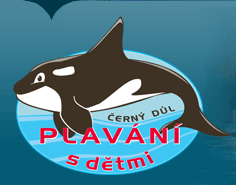Baby swimming in the mountain guest-house MYSLIVNA, Cerny Dul
Myths about swimming
- babies are able to swim after the course
- everything what they learn at the course we are able to teach them at home
- children get cold easily and are often ill
- swimming causes inflammation of the middle ear
- water is dirty because children do a wee-wee into it
- little babies have a bath with another adults and they are endangered by illnesses including veneral ones
- babies have to learn diving at first
- psychomotorical development of little swimmers is forced to increase
- Častý pobyt ve vodě vede k nadměrnému ukládání tuku
Myth: babies are able to swim after the course
A child becomes a real swimmer at the age of four and half a year at least. And moreover the regular trainings three times a week are necessary. A child is ready for learning different swimming strokes at the age of nine but it is better to start earlier to avoid drowning. Swimming courses should teach babies to breath in water, to orientate under water surface, to dive and to float, particularly to be used to having fun in water, wetness in their ears, eyes and nose.
Myth: everything what they learn at the course we are able to teach them at home
If we want to have a good swimmer at home as soon as possible, he or she should be taught by an expert. A child is naturally able to do water movement so called doggie paddle and not to drown but it negatively influences his or her swimming style. In fact, nothing makes him or her do the right strokes: he or she can swim, can´t he(she)? It is the same as you type with two fingers. During a five-year research professionals allowed one group of children to swim naturally and the second group was taught to swim correctly. Nobody drowned but people watching them wanted to rescue the first group of children because their swimming style looked like the fight against natural disaster.
Myth: children get cold easily and are often ill
The youngest babies should swim in special bath-tubs with 37°C warm water, a little bit older ones should have lower temperature. That is the reason that babies shouldn´t use public swimming pools where the temperature is about 26°C. On the one hand babies are cold and on the other hand there is not suitable background for mums and their children.
Breathing against water resistance has rehabilitation effects and it helps children with upper air passages problems. There is not polluted environment in the swimming pool so it is suitable particularly for children suffering from asthma.
Myth: swimming causes inflammation of the middle ear
The question is if the children who suffer from inflammation would suffer from it without water as well. Water gets into ears but chlorine kills all bacteria. Children were given with tampons into ears but they were overcharged for hearing. Doctors say tampons are not necessary, auditory canal drying and playroom acclimatization in winter is more important.
Myth: water is dirty because children do a wee-wee into it
Ten wees are not so harmful like one adult without a shower.
Myth: little babies have a bath with another adults and they are endangered by illnesses including veneral ones
Water circulates. If there is more bacteria, water filter gets a signal and adds more chlorine. Mothers are usually the best police officers because they point out showering in swimming costumes.
Myth: babies have to learn diving at first
In the last days some experts prefer „dolphining“- Russian method based on drill. An adult plunges a child twelve times into water and in that way it imitates a dolphin. Backers of this type swimming say babies do not care because they do not cry but we know they can´t if not to be suffocated. An experienced swimming instructor warns about this violent method. It is an attraction more for adults than for children. Babies are in stress and exhausted. Swimming lessons should be playful and particularly fathers should loose their fear from dropping a child. Ambitious parents are the worst ones if they want their children to do the same what the saw next door.
Myth: psychomotorical development of little swimmers is forced to increase
Pavla Večeřová´s dissertation from Training Institute confirms that children with regular swimming training are more skillful but they do not start walking extremely earlier, not before they are ready for it physically.
Myth: a frequent stay in water causes extra large fat disposal
It is true only for professional swimmers who spend lots of time in pools and moreover it is reaction of a long-time stay in cold water.

